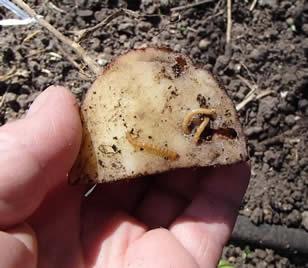by Vancouver Island Master Gardeners Association
Question: What causes holes or tunnels in potatoes?
 Photo courtesy of: Dorothee Kieser.
Photo courtesy of: Dorothee Kieser.
Answer: Wireworms or tuber flea beetles may affect various root crops, especially potatoes, sweet potatoes and onions. On harvesting potatoes, sweet potatoes, and other tubers and corms (e.g., gladiolus and dahlias), show holes or tunnels. Other crops such as onions may show scars.
Season: The problems become evident at harvest time.
Cause: The cause of the problem are the larvae of either the “click’ beetle or the tuber flea beetle. While the damage due to these beetles is very similar, the prevention is somewhat different.
The first step is to identify the source of the problem. Larvae of “click” beetles , i.e, the wireworms are up to 2 cm (3/4 inch) long, They are tough (wiry), and slender and range in colour from light yellow to light brown. They are segmented.
 Photo courtesy of: Linda Gilkeson.
Photo courtesy of: Linda Gilkeson.
Larvae of tuber flea beetles are hard to see as they are slender, cream-coloured grubs.
Remedy:
Wireworms: Because wireworms also attack the roots of grasses, avoid planting potatoes and other susceptible crops in areas that grew sod or grain in the previous few seasons.
 Photo courtesy of: Linda Gilkeson.
Photo courtesy of: Linda Gilkeson.
Wireworms move through the soil depending on temperature. As the soil warms up, they tend to go into deeper layers. Hence waiting until the soil warms up before planting reduces crop damage. Where wireworms are a problem do not plant fall rye as it sustains the pest population and keep garden areas well weeded during the winter to minimize their food supply.
When digging the garden area in the spring, remove as many of the larvae as possible, given their size and colour, they show up on the darker soil. You can also “trap” them by putting a chunk of potato into the ground and removing it every day or few days to check for worms. Make sure to mark the spot so the chunk can readily be found again.
Tuber flea beetles: If these larvae are the problem in potatoes, it is recommended to plant varieties that mature early because beetles multiply during the summer months and hence more larvae are present later in the season. Also ensure that you do not give overwintering beetles a head start by having a ready food supply early in the spring. Overwinter, volunteer potatoes are a good food source for the pest and should be removed as soon as they become noticeable. Also, where infestations are severe, covering the potato bed with floating row covers prior to sprouting.
Reference: For more information on these pests, see Linda Gilkeson: Natural Insect, Weed and Disease Control, 2006, Trafford Publishing.
For gardening questions in the growing season, contact the Gardening Advice Line.

